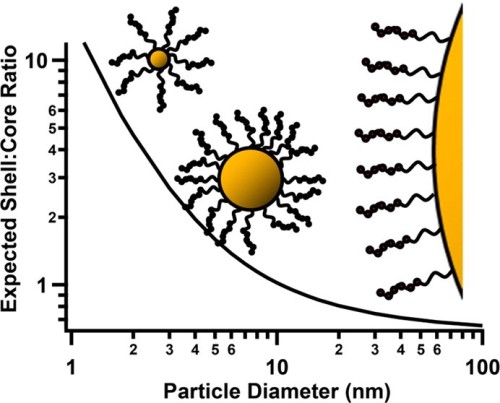This post is part of our ongoing series of public-friendly summaries describing research articles that have been published by members of the Center for Sustainable Nanotechnology. Marco Torelli, a doctoral student at the University of Wisconsin – Madison, was the first author on this paper and collaborated on the study with CSN researchers at the University of Illinois.
The article was first published online in December 2014 in the journal ACS Applied Materials & Interfaces1

“Quantitative Determination of Ligand Densities on Nanomaterials by X-ray Photoelectron Spectroscopy”
First impressions can make a big difference in how people interact. In a similar way, first impressions between different materials can also greatly influence their interactions. When materials (like any of the nanomaterials we’ve discussed many times in this blog) encounter each other, their “first impressions” are formed when their surfaces, which often have some type of coating, interact. A material’s coating plays a HUGE role in how it behaves, because it often dictates how a material will interact with the surrounding world. All of this is to say that understanding the nature of a material’s surface is really important!
In this project, we developed an approach (really, a correction to an existing approach) to determine how many molecules coat the surface of nanoparticles, particularly those that are smaller than 15 nm in diameter. In addition, we made sure that this new approach was accurate.
Why is this helpful? Often times, previous approaches to determine this information made a problematic simplification; specifically, that the curved nanomaterial surface could be treated in the same manner as a flat surface. (Determining coating densities on flat surfaces is something surface scientists have done for quite a while!) This resulted in huge overestimates of the number of molecules coating a nanoparticle, which is a bad thing if one wants to make accurate conclusions about what governs a material’s properties! In addition to this improved accuracy, the correction we developed is a straightforward method that builds upon more complicated mathematical methods that are not as easy to implement. Our goal here was to provide a tool that any lab can use to analyze their results.
Another important note is that often the methods one uses to study something are as important as the focus of study itself. Our research was done as part of the CSN’s effort to improve the approach for how nanomaterials research is conducted. Doing so required combining the synthetic prowess of the Murphy and Hamers labs and can provide great insight into the CSN’s biological experiments such as those that study water fleas or lipid bilayers.
REFERENCES (may require subscription)
1. Torelli MD, Putans BA, Tan Y, Lohse SE, Murphy CJ, Hamers RJ. Quantitative Determination of Ligand Densities on Nanomaterials by X-Ray Photoelectron Spectroscopy. ACS Appl. Mater. Interfaces 2015 7(3), 1720–1725.
